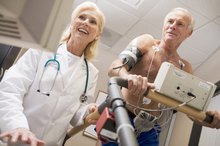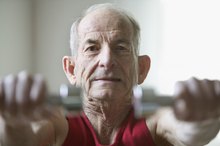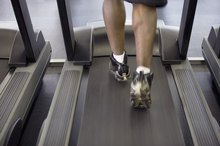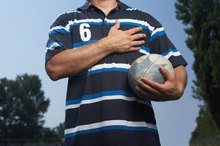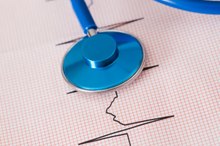Signs & Symptoms: Dizziness & Loss of Vision During & After Exercise
Exercise stresses the body -- stress is what causes the positive results -- but exercise should not cause frightening symptoms like dizziness or loss of vision. When you experience negative symptoms like these, it is your body's way of telling you that something is wrong. Dizziness and vision loss may be caused by low blood pressure or low blood glucose. Contact your doctor if you experience dizziness or vision loss.
Hypotension
Hypotension occurs when your blood pressure falls too low; symptoms include both dizziness and blurry vision. Health professionals measure blood pressure force in millimeters of mercury, abbreviated mmHg. A blood pressure reading of 90/60 mmHg or less is considered to be hypotensive. When symptoms such as dizziness and loss of vision accompany hypotension, there may be an underlying condition as a cause.
- Hypotension occurs when your blood pressure falls too low; symptoms include both dizziness and blurry vision.
- A blood pressure reading of 90/60 mmHg or less is considered to be hypotensive.
Causes of Hypotension
Dizzy & Lightheaded When Exercising
Learn More
The normal response of blood pressure during exercise is a rise in systolic pressure in direct proportion to exercise intensity, and a stable or lowered diastolic pressure. Systolic pressure represents the force on the blood vessel walls during a contraction, or heart beat. Diastolic pressure is the lowest point of force and occurs while the heart is at rest, or filling. According to Dr. Robert J. Matthews, founder of the website Cardiology, hypotension during exercise indicates underlying heart disease 1. If this occurs, stop exercise immediately and contact your doctor. Better yet, if you are at risk for heart disease, gain medical clearance before starting any exercise program.
- The normal response of blood pressure during exercise is a rise in systolic pressure in direct proportion to exercise intensity, and a stable or lowered diastolic pressure.
- Diastolic pressure is the lowest point of force and occurs while the heart is at rest, or filling.
Hypoglycemia
Hypoglycemia is a condition in which your blood glucose falls below a normal and healthy range. Blood glucose levels are represented as milligrams of glucose per deciliter of blood, or mg/dL. A worrisome blood glucose level is usually considered less than 70 mg/dL. Experiencing hypoglycemia during and after exercise has a certain logic, because during exercise, your muscles use blood glucose for energy production.
- Hypoglycemia is a condition in which your blood glucose falls below a normal and healthy range.
Treatment of Hypoglycemia
What Are Normal Blood Pressure Results During a Stress EKG?
Learn More
In general, hypoglycemia will not occur in healthy individuals during or after exercise 4. If you are diabetic, take action to test your blood glucose before and after exercise to maintain healthy blood sugar levels. If you do experience hypoglycemia during exercise, consume carbohydrates, such as a sports drink. After exercise, hypoglycemia can occur because the reduction in muscle glycogen stores causes muscle cells to take in a great deal of blood glucose. Smart recovery from exercise means eating a high-carb snack or meal between 30 and 60 minutes after exercise.
- In general, hypoglycemia will not occur in healthy individuals during or after exercise 4.
Related Articles
References
- Cardiology: Exercise Test; Dr. Robert J. Matthews
- Net Doctor: Hypoglycemia; Dr. Patrick Davey; February 2011
- "Exercise Physiology"; George A. Brooks, Thomas D. Fahey, Kenneth M. Baldwin; 2005
- Diabetes In Control.com: Preventing Hypoglycemia During and After Exercise; Sheri Colberg, Ph.D., FACSM; March 2009
- Service FJ, Cryer PE, Vella A. Hypoglycemia in adults: Clinical manifestations, definition, and causes. UpToDate. Updated March 14, 2017.
- American Diabetes Association. 6. Glycemic Targets: Standards of Medical Care in Diabetes-2020. Diabetes Care. 2020;43(Suppl 1):S66-S76. doi:10.2337/dc20-S006
- Kishnani PS, Austin SL, Abdenur JE, et al. Diagnosis and management of glycogen storage disease type I: a practice guideline of the American College of Medical Genetics and Genomics. Genet Med. 2014;16(11):e1. doi:10.1038/gim.2014.128
- Desimone ME, Weinstock RS. Non-Diabetic hypoglycemia. In: Feingold KR, Anawalt B, Boyce A, et al., editors. Endotext. Updated September 23, 2017.
- Kalra S, Mukherjee JJ, Venkataraman S, et al. Hypoglycemia: The neglected complication. Indian J Endocrinol Metab. 2013;17(5):819-34. doi:10.4103/2230-8210.117219
- Martín-Timón I, del Cañizo-Gómez FJ. Mechanisms of hypoglycemia Unawareness and implications in diabetic patients. World Journal of Diabetes. 2015;6(7):912-926. doi:10.4239/wjd.v6.i7.912.
- Mayo Clinic. Hypoglycemia. Mayo Clinic Staff. Updated February 16, 2018.
- Service FJ, Cryer PE, Vella A. Hypoglycemia in adults: Clinical manifestations, definition, and causes. Updated March 14, 2017.
- Hormone Health Network. Nondiabetic Hypoglycemia. Endocrine Society. Updated October 2017.
Writer Bio
Laura Niedziocha began her writing career in 2007. She has contributed material to the Stoneking Physical Therapy and Wellness Center in Lambertville, N.J., and her work has appeared in various online publications. Niedziocha graduated from Temple University with a Bachelor of Science in exercise science. She also has her Associate of Arts in communications from the Community College of Philadelphia.

